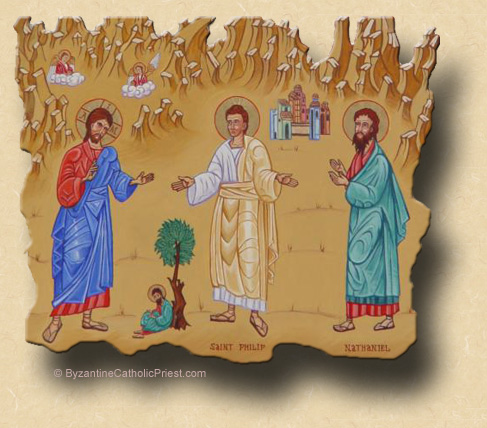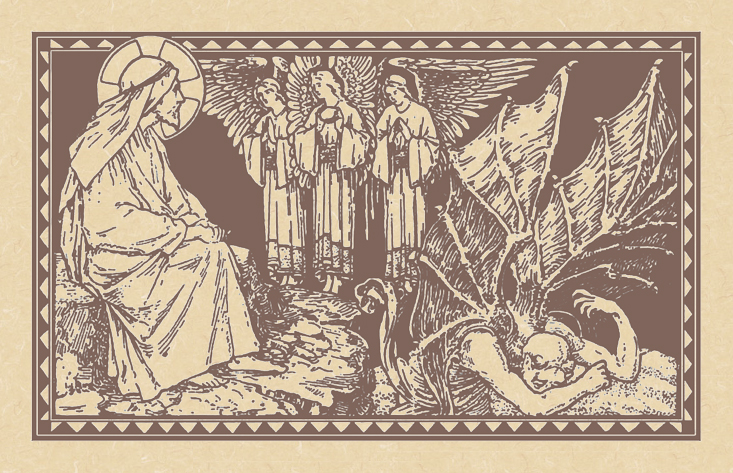Ask Not "Who Is Jesus to Me?" but "Who Am I to Jesus?"*
The First Sunday of the Great Fast; the Sunday of the Memory of the Holy Prophets; the Sunday of Orthodoxy; and, the Feast of the Finding of the Venerable Relics of the Martyrs at Eugenia.
Lessons from the triodion, according to the typicon of the Byzantine-Ruthenian Rite:
• Hebrews 11: 24-26, 32—12: 2.
• John 1: 43-51.
The First Sunday of Lent.
Lessons from the secondary dominica, according to the ordinary form of the Roman Rite:
• Genesis 9: 8-15.
• Psalm 25: 4-9.
• I Peter 3: 18-22.
• Mark 1: 12-15.
Lessons from the dominica, according to the extraordinary form of the Roman Rite:
• II Corinthians 6: 1-10.
• Psalm 90: 11-12.
• Psalm 90: 1-7, 11-16.**
• Matthew 4: 1-11.
FatherVenditti.com
|
 10:17 AM 2/22/2015 — The celebration of the First Sunday of the Great Fast in the Byzantine-Ruthenian Tradition has gone through an evolution over the centuries. Originally it was a commemoration of the Old Testament prophets and their prophesies concerning our Lord; hence Philip telling Nathaniel, "We have discovered who it was Moses wrote of in his law, and the prophets too...” (John 1: 45); not to mention the reading from Hebrews, which is all about the prophets and their sufferings. Then, following the iconoclastic controversy, the focus of this Sunday changed, and became a celebration of the restoration of the veneration of icons throughout the Church; hence it's still popular title, "The Sunday of Orthodoxy" or "The Sunday of the True Faith." In quite a few parishes in our Church, this has now become the only focus of this Sunday, with children re-enacting the procession with icons led by Empress Theodora in 842; and, some of our priests have become fanatical about observing that custom because it is so idiosyncratically Eastern. 10:17 AM 2/22/2015 — The celebration of the First Sunday of the Great Fast in the Byzantine-Ruthenian Tradition has gone through an evolution over the centuries. Originally it was a commemoration of the Old Testament prophets and their prophesies concerning our Lord; hence Philip telling Nathaniel, "We have discovered who it was Moses wrote of in his law, and the prophets too...” (John 1: 45); not to mention the reading from Hebrews, which is all about the prophets and their sufferings. Then, following the iconoclastic controversy, the focus of this Sunday changed, and became a celebration of the restoration of the veneration of icons throughout the Church; hence it's still popular title, "The Sunday of Orthodoxy" or "The Sunday of the True Faith." In quite a few parishes in our Church, this has now become the only focus of this Sunday, with children re-enacting the procession with icons led by Empress Theodora in 842; and, some of our priests have become fanatical about observing that custom because it is so idiosyncratically Eastern.
As you know, I have usually chosen to focus on the Gospel passage itself, which recounts our Lord’s first meeting with Nathaniel: how he spied Nathaniel coming from a distance and could immediately read the state of his soul which, luckily for Nathaniel, was “without guile”, as our Lord put it; and, from this I have always asked you to meditate on the fact that Christ is able to see into the darkest corners of our hearts, even into places where we ourselves have ceased to look; and, I remember giving you an analogy about our souls being like our computers: we think we have a good firewall in place, and our anti-virus software is up to date, but our Lord still gets in and is able to see what we think we’ve long since deleted and now forgotten about. A practical Lenten reflection which you can take for what it’s worth.
With all these competing ways of observing the First Sunday of the Great Fast, is there any one thing that strikes at the essence of the commemoration? In asking myself that question, I found myself re-reading John Chrysostom’s homily on the first chapter of John's Gospel, and came across a little exposition on something that the Evangelist reports in today's Gospel almost in passing: after our Lord tells Nathaniel how he saw him under a fig tree—how he saw the purity of his soul—Nathaniel says to Jesus, “Rabbi, You are the Son of God! You are the King of Israel!” Chrysostom points out that the first part of that statement—”Rabbi, You are the Son of God!”—is, word for word, exactly what Peter says to Christ after the miraculous catch of fish; but, Peter is responding to a rather impressive miracle. When Nathaniel says it, he hasn’t seen any miracles—unless you want to count Jesus seeing him under the fig tree, which certainly doesn’t rise to the level of raising Lazarus from the dead or giving sight to the blind or even the miraculous catch of fish. Jesus’ public ministry has not yet begun at this point; he’s still collecting his apostles around him. Obviously, when Peter calls Jesus the Son of God, he means something very different than what Nathaniel means. Nathaniel adds to the end of that statement, “You are the King of Israel!” We will never know exactly what Nathaniel meant by that: whether it’s a political statement or reference to a sort of spiritual kingship we don’t know. Certainly, recognizing Jesus as King of Israel—whatever it means—is a far cry from recognizing Him as God; and, Chrysostom points out that this is an important point for us: Nathaniel sees Jesus as he is able to see Jesus, having had no previous experience with Him.
Nathaniel disappears from the Gospel after this; we know he is there, but what he may have said or done after this point is not recorded. It’s safe to assume that his understanding of exactly who and what Jesus is grew and developed over time, as it did for all the apostles. Some, like Peter and John, knew early on that Jesus was God;—they had figured it out—some of the others didn’t realize it until after our Lord had risen from the dead.  Judas began where Nathaniel may have begun, seeing Jesus as a political figure with spiritual overtones; but, when he realizes that there isn’t going to be a revolution to overthrow the Romans, he becomes disillusioned and betrays our Lord. He does realize it at the end, after his betrayal, and that realization drives him to suicide. Judas began where Nathaniel may have begun, seeing Jesus as a political figure with spiritual overtones; but, when he realizes that there isn’t going to be a revolution to overthrow the Romans, he becomes disillusioned and betrays our Lord. He does realize it at the end, after his betrayal, and that realization drives him to suicide.
What we have to figure out is how we choose to recognize our Lord; and, we are all at different stages in that process. Those who cling to a purely secular and social interpretation of the Gospel would see Jesus as a social and political teacher who inspires us to be concerned for the poor and the downtrodden and the oppressed, but I doubt they would see him as any kind of god to whom is owed worship and some form of personal, moral commitment. By contrast, in a previous life I once had a Buddhist coworker who saw in Jesus a spiritual guru with great mystical teachings to impart, but with no understanding of Jesus having any kind of message beyond being at peace with ourselves. The bottom line is: we do not have a right to invent Jesus Christ: He is who he is regardless of what any of us think of him.
Three thousand years before God became a man in the person of Jesus Christ, God and man had the first really meaningful conversation with one another since Adam and Eve were expelled from the Garden: Moses approached the burning bush and asked, “Who are you?” And what were God’s first words to man in over a thousand years? “I am Who I am!” And God has never changed his identification of himself. When he appeared to Jeremiah the Prophet, he said, “Before I formed you in the womb I knew you.” When the Man Born Blind asked him where he could find the Messiah, Jesus said, “I who speak to you am he.” When Jesus spoke to Saul on the road to Damascus, Saul asks, “Who are you, Lord?” And God’s response: “I am He whom you are persecuting.” The Epistle to the Hebrews: “Jesus Christ: yesterday, today and the same, forever.” We do not define Christ. He defines us.
As for those who still choose to make up Jesus for themselves to suit their own agendas, St. John probably said it best: “He was in the world, and the world was made through Him, yet the world did not know Him. He came to His own, and His own did not receive Him. But to those who did receive Him, He gave the right to become children of God” (John 1: 10, 12). And if you are searching for some theme to guide your observance of the Great Fast this year, you might consider this: ask yourself not “Who is Jesus to me?” but “Who am I to Jesus?” Are you Cain, being asked by God, “Where is your brother?” Are you Elijah, looking for God in the magnificence of nature, and missing him standing right there next to you? Are you Judas, looking for Jesus to solve the world’s social and political ills? Are you Peter, looking for God to save you as you sink into the sea? Are you Nathaniel, who doesn’t know who Jesus is, but only knows, at this point, that he is something he has not encountered before?
Even after six thousand years of Divine Revelation, each one of us still has the task of engaging Christ on a personal level, coming to grips with who He is, and what that means to the way we choose to live our lives. The first step is to let Jesus define Himself. The next step is to then let Jesus define us.

* There is but one public Mass each day at the Shrine of Our Lady of Fatima, and I have assigned it today to the retired priest who lives with me; therefore, in order not to leave this site without a post for the First Sunday of Lent, I am reposting here a homily from two years ago, from when I was a pastor in the Byzantine-Ruthenian Church. I chose this particular homily because, sadly, too many priests of that Tradition continue to focus on the single aspect of this Sunday as a celebration of the Restoration of Icons, escewing its more important and historical aspects.
** Some have inquired why I include a psalm when listing the lessons in the extraordinary form, especially since there is nothing called "the Responsorial Psalm" in that form; however, in actuality, there is: what the Missal of St. John XXIII calls the Gradual is what became the Responsorial Psalm in the Novus Ordo, though it usually consists of only one or two verses and is not done in a responsorial way. On certain important Sundays and feasts, an additional psalm is added, called the Tract, which is why there are two psalms indicated for today.
The banner image at the top of this page shows our Lord's temptation in the desert because that is the Gospel lesson for this Sunday in the extraordinary form.
|

